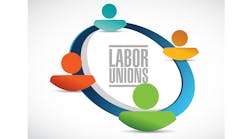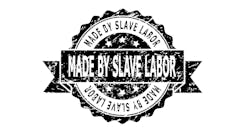COMMENTARY
Unions have been suffering declines in membership, but the good news is they now have a powerful ally with ambitious plans to help them in the Biden administration. The bad news for unions is that all of this effort may not be enough in the end.
Since his very first day in office, President Biden directed a series of efforts to help his and the Democrat Party’s union allies, who lent crucial support in recent elections. This was not unexpected by anyone and we’ve seen federal actions and pronouncements emanating from a series of administration officials over the past year.
The most recent evidence of this pro-union bent is release of a report issued by the White House Task Force on Worker Organizing and Empowerment, putting forward a series of recommendations for the federal government agencies about how they can do even more on behalf of these vital administration allies.
The task force report got a scathing review from the Coalition for a Democratic Workplace (CDW), which includes among its more than 500 members employer and industry groups such as the U.S. Chamber of Commerce, National Association of Manufacturers, National Federation of Independent Business and the American Trucking Associations.
“Today’s report from the White House task force is nothing more than pro-union propaganda and exemplifies how entrenched pro-union allies are in this administration," said CDW chair Kristen Swearingen. “Instead of trying to solve any of the many problems real American families are facing, like inflation or the supply chain crisis, union allies in the White House are focused on finding ways to boost union membership to pad their coffers and restore the influence of their former employers.”
The unions need all the help they can get. The federal Bureau of Labor Statistics (BLS) recently released its latest statistics for union membership and they are not good. In 2021, the number of wage and salary workers belonging to unions continued to decline (-241,000) to 14 million, and the percent of the workforce who were union members was 10.3%.
When you separate out the public employee union membership, only 6.1% of the private sector workforce belongs to unions, with the percentage of government union workers being five times more than those in the private sector. Compare that to the 1950s when total union membership in the United States exceeded 30%, including government employees.
Last year, President Biden created the labor task force, headed by Vice President Kamala Harris and Labor Secretary Marty Walsh, with the rest of the membership consisting of other cabinet officers and top White House advisors. The group was charged with brainstorming ideas that could be used to administratively impose the goals of the Protecting the Right to Organize Act (PRO Act), a massive bill that was passed by the House but stalled in the Senate.
Many of the myriad of ideas contained in the task force report are familiar to those who have followed the twists and turns of labor regulation in recent decades. Described by some observers as a “laundry list,” the copious recommendations contained in the 46-page report are a grab bag of proposals— some unobjectionable, like supporting expanded apprenticeship programs. Others would lend the full backing of the administration for proposals hatched during the Obama administration to make it easier for unions to wage organizing campaigns and harder for employers to oppose them.
Extending Labor’s Reach
A good example of what the federal government can do to promote union interests are the labor protection provisions in the only major bill on Biden’s ambitious legislative agenda that managed to get passed by Congress, the Infrastructure Investment and Jobs Act. It contains protections for organized labor working on projects funded by the new law, as well as set asides and requirements that all workers on those projects be paid the prevailing union wage.
The task force adds a recommendation that the Department of Labor (DOL) prioritize review of Davis-Bacon and Related Acts regulations, which generally require contractors—both union and non-union—who work on federal and federally-funded contracts to pay their workers under labor-friendly wage standards.
The task force also seeks to encourage the use of Project Labor Agreements, which are project-specific collective bargaining agreements, in regard to projects receiving federal assistance from the Treasury, Environmental Protection Agency, and Departments of Transportation, Commerce, the Interior, and Veterans Affairs.
In other areas, the recommended activities are not likely to be of much help to unions in achieving their membership building goals, although they are sure to keep lawyers busy. For example, the task force urges DOL and the National Labor Relations Board to adopt “persuader” rules that will require employers involved in organizing campaigns to reveal information about the law firms and labor consultants they’ve hired to oppose a union’s organizing efforts.
It’s hard to believe that the employees targeted by a union in such a circumstance are really going to be persuaded to join a union because their employer hired a legal or consulting firm, but the persuader rule has been a union goal for many years. When it comes to the task force report, the language in the report seems to spell out that they are offended that employers are allowed to oppose a union organizing campaign at all.
In a similar vein, it is difficult to imagine that unions will be able to benefit much if at all from the task force recommendation that various federal agencies hand out pamphlets at job fairs explaining the rights of workers to organize and to join unions. However, this is the natural outcome of the union view embraced by the authors of the task force report that the decline in union membership is due to aggressive anti-union campaigns waged by private employers over the years.
CDW employer coalition chair Swearingen dismisses the notion that the declining number of employees being represented by unions should even be considered a priority for a government struggling with other, real crises, like the COVID-19 pandemic, rampant inflation and the ongoing supply chain crisis. “We strongly urge members of Congress to focus on real problems that exist, instead of manufactured ones like shrinking union ranks, and reject the radical labor provisions being pushed by pro-union allies and union lobbyists.”
One challenge that may be impossible for private sector unions to overcome is the changing world of work, which has been accelerated by the Coronavirus. It’s not easy to organize people who are working from home, or gig workers who, due to the nature of their professional pursuits, don’t think of themselves as the natural brothers and sisters of assembly line workers and coal miners.
Another barrier to rebuilding union ranks is the poorly understood phenomenon now being called “the Great Resignation.” This designation covers the shrinking participation in the national workforce and which has led to the inability of many employers to find willing workers even after many pandemic restrictions have waned. Although many reasons have been suggested for why this trend has taken firm root and is growing, no one is sure why it is happening or how the dropouts are supporting themselves now that many pandemic programs have ended.
One suggested possibility is that the gig worker trend gained greater popularity as workers have turned to freelance and independent contractor occupations to support themselves. This is bad news for unions, and is the major reason they have been fighting tooth and nail to end independent contractor status in states across the nation and by changing federal law.
The one thing unions and their political allies have yet to do is stop blaming anti-union employer activities for their inability to attract enough votes to swing an organizing campaign event, as was the case in an automotive plant loss in recent years when management of the parent company helped the union by not waging a campaign against it.




